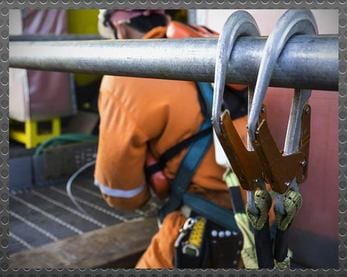- About Us
- Our Services
- Training Expertise
- Crisis Management for Business & Industry
- DOT PHMSA ALERT Rail Car Training
- Emergency Management
- Environmental & HAZMAT
- First Response & HAZWOPER
- Maritime Security
- OSHA Training/Confined Space
- RDPC
- Safer News Gathering
- Safer Ohio Schools Using Threat Assessment Management
- School Safety & Security
- Workplace Violence Prevention
- Courses
- Our Clients
- Media
Preventing Falls By Rule And Ritual, Part Two

Last Tuesday, we talked about how a safety mindset works as a form of carry-around fall protection, in its own way as effective as handrails and lanyards.
This time, we’ll look at the 2017 changes to OSHA regulations that are intended to reduce the number of on-the-job falls to the same level and to lower levels. These were published in November of 2016, scheduled for enactment over the course of this year, and the last of these will be codified next month. The final rules apply to all general industry employers.
The key term to understand here is ‘walking-working surfaces’, all of which are covered by the updated regulations. OSHA defines a walking-working surface as any “horizontal or vertical surface on or through which an employee walks, works or gains access to a work area or workplace location.” This definition expands the category of areas established by 29 CFR 1910.22. Walking-working surfaces now include spaces where an employee may not be expected to perform a work-related task. So, most any hallway, public and private entrances, locker facilities, break rooms… All these areas are now covered by OSHA safety rules.
Regular inspections are the first component of this collection of regulatory changes. All walking-working surfaces must be routinely inspected to ensure they are free not only of obvious defects but of any kind of contaminants or other imperfections. Minor flaws in walkways are often ignored, and changes in environmental conditions can exacerbate these defects without easy notice. The result may be a weakened stair step or loosened handrail, and an accident is almost sure to follow. Employers are now required to immediately guard employees, contractors, and visitors from such hazards until such time as the hazardous condition is rectified. New specifics are found in the updated rules, stating that “sharp or protruding objects, loose boards, corrosion, leaks, spills, snow, and ice” must be repaired, removed, or otherwise eliminated in a timely manner. And DIY is not always acceptable; Such corrections must be made by a qualified person as defined by existing OSHA standards.
Along with inspections of common walking areas, employers are now required to identify all fall hazards in their facilities and introduce fall protection systems, or engineering or administrative controls to prevent injuries.
In previous versions of OSHA fall-prevention regs, guardrails were almost the sole prescription for many risky areas. The new rule (with section title ‘Duty to Have Fall Protection’ [29 CFR 1910.28]) allows for, and encourages, the use of other means to protect workers and visitors any time they are four or more feet above a lower level. Allowable safety features now include safety nets, fall arrest systems, travel restraints and others.
Other revised and added categories within the scope of the regulations refer to Fall Protection Systems and Falling Objects Protection (portions of which become enforceable November 18, 2017), Stairways, Ladders and Stepbolts, Dockboards, and Scaffolds and Descent Systems. All of these classifications have more detail to consider that we have space for in Tuesday Training. A good place to start examining the details is the updated OSHA fact sheet found here.
Also included (as 29 CFR 1910.30) is a requirement for Fall Protection Training. Workers who may be exposed to fall hazards must now be trained as to where those hazards are, and what steps have been taken to prevent mishaps in those areas. Employees must be trained on how to not only use fall protection systems, but how to install, inspect, and maintain those systems. Retraining is needed in a number of circumstances, such as when there are any changes to fall protection systems, or if an accident takes place despite the existence of proper safety features.
Such training is required to be created and presented by an OSHA qualified trainer, and this is where Findlay All Hazards steps up to the plate. Findlay program managers and trainers bring decades of practical experience to any industrial setting. Findlay presents instruction that is consistent with current regulations and also designs a customized training program that focuses on your specific organization, and your practices and policies. Contact Findlay All Hazards today to find out about walkway and fall protection evaluation an on-site training.
